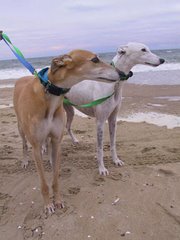IHT, with this post about her goals and increasing her running distance with her dog, has gotten me to really think about how far I plan to run with Cosmo. W and I have discussed it a few times while running but as we start to really increase our distance, it is something I seriously have to consider. So far, the boy is the picture of health - his feet and pads (a little obsession of mine as we run on asphalt sometimes) are perfect, so says the vet. His heart is strong and solid. After runs, he is tired but he is never stiff or slow moving (unlike me!).
The problem is he loves to run and would probably run himself into the ground before stopping. It goes without saying that is unacceptable. I know he can do 5/6 miles if the weather is cool enough. Can he go longer? Can he do 8 or 9 miles or even longer? I know there is a distance where humans have to start taking in calories to keep going. I assume the same would be true for Momo.
Of course, internet searches have turned up almost nil in the information department - just lists of distress signs you should watch for. Yeah, I don't want to wait to see my dog distressed before I stop him. Just how far can Cosmo go?
Running is a big question mark that’s there each and every day. It asks you, ‘Are you going to be a wimp or are you going to be strong today?' - Peter Maher, Irish-Canadian Olympian
Monday, July 02, 2007
Subscribe to:
Post Comments (Atom)


3 comments:
The question is how far can you (or want to) run and how fast. If you keep a pace that is comfortable for him and you then I think he would be fine for upwards to 6 miles. My opinion that would be the max for a greyhound because of their build.
I agree that a human pace is easy for a dog to maintain for long distances.
Bonnie has gone up to 40 miles with me and many times over 20. These were mostly trail miles, but she never seemed the worse for wear or tired the next day.
We were the only human-canine team to finish a hot and difficult (for me) 28 mile trail run. I think she managed relatively easily because I'd not feed her breakfast that morning and I carried water for her and stopped for her to drink often instead of waiting until aid stations.
I always carry enough water for both of us on training runs.
Sled dog handlers use maltodextrin as an easily digestible energy source, sometimes mixed with chicken broth. I give Bonnie a little Vanilla Hammer Gel if we are out more than 3 hours. Vanilla or Plain Hammer seem to be the cleanest portable maltodextrin sources, but I am not sure what's in all the patented ingredients so investigate for yourself.
BE CAREFUL!! Many human sports foods have xylitol which is toxic to dogs. There is more info about that on my blog. I never give sports drink to Bonnie. Most have xylitol.
Also, dogs don't sweat so giving them electrolytes puts an additional strain on their system. Some companies sell doggy electolyte drinks. Just one example that you cannot trust that dog specific products are good for dogs.
Back to the no breakfast thing. Dogs digest food and store calories differently than we do. There are some good articles about this on Purina's website, mostly written by or for sled dog competitors. Basically a dog can eat a very large meal many (12 or more) hours before exercise and those calories will be readily available to them. Digestion raises their body temperature for something like 6 hours. Since their cooling systems are underpowered we want to avoid raising their temp before exertion. It can also cause injury to have solids banging around in their colon.
Great info fourwhitefeet. i have a 4 year old labX. He's about 100lbs and runs with me. He has gone over 20 miles many times and enjoys our morning 6-8 milers tons. I plan on running across Canada next year. 30 miles a day. If it's hot i plan on splitting it up morning and night. I and he thinks he can do it. Any thoughts?
Animal
Post a Comment